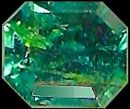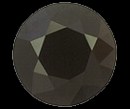Serendibite Info
Back to Serendibite
 |
| Serendibite / Sri Lanka * |
Serendibite was named in 1902 (by Prior and Coomaraswamy) after the old Arabic term for Sri Lanka: Serendib. It is only rarely found as facet grade material.
* Photo by kind permission of George Bosshart.
Formation and Resources
 |
| Serendibite / Myanmar * |
The genesis of serendibite depends on the facies of replaced skarns and calcareous-skarn alteration of the primary composition of the host rocks. Serendibite crystallized during the postmagmatic stage of the evolution of boron mineralization at skarn deposits of both the abyssal and the hypabyssal facies, in contact with magnesian carbonate sequences and desilicified aluminosilicate rocks.
In 1932, noteworthy serendibite crystals were found in skarn assemblages in Warren County / New York / U.S..
Recently, serendibite was also discovered in the Ohn Gaing mine / Mogok / Myanmar. These stones are black, in contrary to the greenish-blue or violet-blue stones from Sri Lanka.
* Photo by kind permission of © www.multicolour.com, David Weinberg.
Other deposits:
Tanzania: Handeni District / Tanga Region
Madagascar: Zazafotsy Quarry and Vohimena hill / Ambahatraso / Amboarohy / Ihosy department / Horombe region / Fianarantsoa province, and Ianapera emerald deposit in Sakalava / Ianapera area / Benenitra Department / Toliara Province
Russia: Tayozhnoye iron deposit / Aldan Shield / Yakutia / eastern Siberia
U.S.: Crestmore quarries resp. New City quarry / Riverside County / California, Edenville resp. Warwick / Orange County / New York, Johnsburg / Adirondack Highlands / Warren County / New York, Russell / Adirondack Lowlands / St. Lawrence County / New York
Canada: Melville peninsula / Northwest Territories
⇐ Intro Page ⇐ Gemstones ⇐ Serendibite